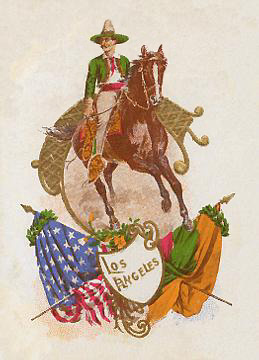
A Visit to Old Los Angeles and
Environs
Part 1.
Arrival.
by
Brent C. Dickerson
Copyright © Brent C.
Dickerson

The author would like to thank California State University, Long Beach, for generously supporting this awarded heritage project—evidently the most complete pictorial survey ever published of downtown Los Angeles of the era 1900-1920—by making available the webspace for it to appear. The Los Angeles of this era is a Los Angeles few have any notion of! Warm thanks are also due to the late Dan Tillmanns for help with several details, and to John Dykeman for preparing some of the audio files. Most images on this site are from originals in the site creator's own archive; the few others are either public domain images from "free to use" sources such as the Library of Congress or are from purchased reproductions represented by the seller as being in the public domain. We very much respect and believe in copyright protection, and request that, should a copyrighted image be included unintentionally on this site—that is, an image which is currently protected by an active (not expired) copyright—that the copyright owner or representative contact us so that we may remove it. This site was designed with viewing on the traditional 4:3 monitor in mind. Comments and corrections are welcome, even encouraged, and may be addressed to the author at odinthor@csulb.edu .
Index of Episodes.
1. Departure and
Arrival. En Route. Plaza. Main south to Temple. Index of
Episodes. Site awards.
2. East of Main
Street. Chinatown. Alameda St. San Pedro St. Los Angeles St.
3. Main
Street (part 1). South to Fourth Street.
4. Main Street (part
2).South to Eighth Street.
5. Spring Street
(part 1). South to Fourth Street.
6. Spring Street
(part 2). South to Eighth Street. Mercantile Place.
7. New High Street.
Justicia/Buena Vista Street. Broadway (part 1). North of First St. Map of downtown.
8. Broadway (part
2). First Street to Fourth Street.
9. Broadway (part
3). Fourth Street to Eighth Street.
9a. Later Around
Broadway and Eighth Street...
10. Hill Street
(part 1). From Temple Street south to Fifth Street. Clay
Street.
11. Hill Street
(part 2). From Fifth Street south to Eighth Street. Central
Park.
12. Olive Street.
Third Street. Angel's Flight. The Auditorium. From Second Street south
to Sixth Street.
13.
Grand Avenue. State Normal School. Bunker Hill Avenue.
14. Hope Street
and Flower Street.
15.
Figueroa Street. South to Pico.
16. A Fiesta.
Elysian Park. The Orphan Asylum. More Chinatown. Sonoratown.
17. South of
Downtown, and Some City
Parks. Hospitals. East Lake Park. Hollenbeck Park. St. James
Park. West Lake Park.
18.
Hollywood and Venice. Echo Park. Paul de Longpre's. Soldier's Home.
Santa Monica. Venice Pier.
19. Ocean Park,
Redondo Beach, and the Oilfields.
20. San Gabriel,
Eagle Rock, and Casa Verdugo.
21. Pasadena,
Mt. Wilson, and Mt. Lowe.
22. Long Beach
(part one).
23. Long Beach
(part two). Signal Hill.
24. Long Beach
(part three): Pier and Pike.
25. San Pedro,
Los Angeles Harbor, and Pt. Fermin.
26. San
Pedro again; Catalina (part one). Voyage to, and arrival at,
Avalon.
27. Catalina
(part two). Catalina shoreline, Seal Rocks to Descanso
Canyon.
28. Catalina
(part three). Around town in Avalon.
29. Catalina
(part four). The inland tour. Return to the mainland.
30. How It All
Ended.
• Los Angeles City Hall tower (located on Broadway), looking east from the 200s block of Olive Street on Bunker Hill, circa 1905.

This is a pictorial survey of downtown Los Angeles, and certain other areas, focusing on the years 1900 to 1915, though occasionally making use of images from other times. This series will follow, primarily by means of actual postcards of the era, the travels of a farming family from the great plains as they visit Los Angeles and its environs in the early years of the Twentieth Century. Some of the postcards and pictures are pristine; others show their experiences in their cancellation marks, creases, flakings-off of image, or in the writing by their excited or amused original senders. Some pictures, and especially the printed words on them, will appear blurred on the monitor due to the necessity of providing reasonably shorter download time for the viewer. Get out your comfortable shoes, your most umbrageous hat, your walking stick! We join our travelers as they roam the streets, and visit with them what we as well as they do not know—the points of interest as well as the scenes of everyday life in old Los Angeles...
Departure. En route.
• Greetings from Los Angeles! A postcard arrives from Aunt Sigrid in Los Angeles, California. "I live under the first 'E' in 'Angeles'," she wrote; "As you can imagine, it's very shady." "The ultimate effect of the card," recounted brother Charley, who spent two years in college before being expelled, "was to invite us there for an extended visit."
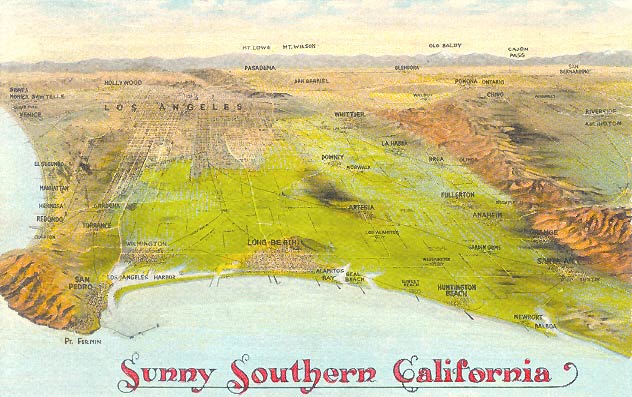
• Our travelers, and their extended family. You surely can pick out Papa, Mother, Charley, Minnie, Anna, young Frederick Johan, the baby, and me.

• Our prairie home.
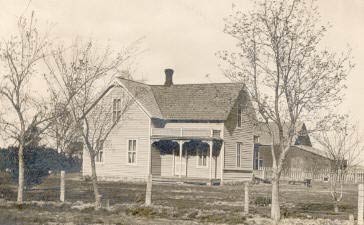
• Our prairie farmfields.
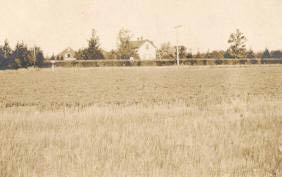
• Our prairie church, where the people of the parish wished our travelers a safe and happy trip that Sunday before they left.
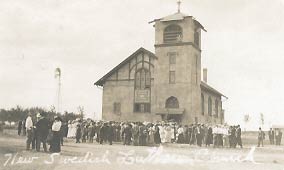
• You'll recall, dear, that on our way to the station, we all got caught in the circus parade—you in your dray with your father, us coming from the opposite direction clip-clopping along in Mr. Sherry's contraption. At least it held us all! Minnie grabbed my sleeve and said she thought one of the elephants took a wrong turn, down 2nd Street, towards the drug store near your house. "What fun—won't someone be surprised!" said I. Did you see it, coming back from the station? I promised I'd write and send you back pictures of our trip; do I start at the beginning, or what?

• After our own tender goodbye—only a few more months, dear—we all got on board and everything went smoothly...at least, it did once we found young Frederick Johan, who was busy asking the engineer questions about the machinery. I'm afraid I became a bit heated when I saw him a car away, pestering the railroad men. "What the devil are you doing, FJ? Come back here with the rest of us!" Of course, Mother caught me out on that one—"Don't call on the devil, Ulf; he doesn't need to be any busier than he is already."
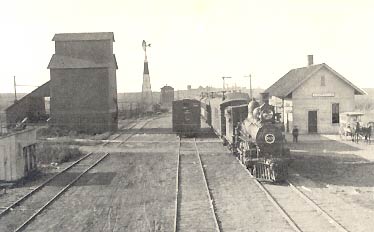
• After the train finally got underway, we quickly settled down—one of us too much, it would seem. I awoke from a reverie to see Anna staring at me with some concern. "Oh, great gracious, Anna—it's to use trying to talk to him!", cried Minnie, throwing her hands in the air. Charley smirked, "He's thoroughly besotted with Love, heaven help him." I was indignant, indeed I was: "I have no idea what you're talking about. None whatsoever. Not a smidgin." Papa sighed, "Leave the boy alone, children. You have no idea what it does to a man." "Charley in particular has no idea what it does to a man!", added Minnie. At this point, I enquired, "What what does to a man, if anyone would be so kind...?" This only gave young Frederick Johan a chance to start singing, "...Just crazy 'bout that wonderful thing, that beautiful thing, that sweet little thing, that precious little thing called Love!"

• Fortunately for all concerned, this little musicale ended—but not soon enough for me—and the weary miles began to settle into a regular pattern: Papa dozing, Mother chatting with the reverend's widow (she got off at Salt Lake City to visit her nephew), Charley playing cards in the club car (poker, I think!—at any rate, he told me he was playing cards with "a diabolical doctor who cured me of a great deal of my pocket money!"), Minnie making eyes at the conductor, me thinking of you of course dear, Anna holding the baby and gazing at the scenery, young Frederick Johan exploring, and the baby crying. We crossed the Salt Lake during the night. The creaking of the trestles bothered me; but Papa sat at the window calmly smoking a cigar and looking out over the lake.
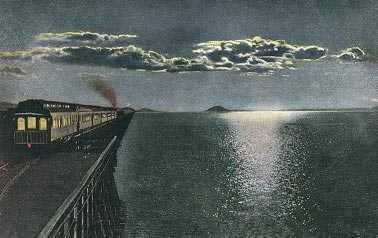
• And so, here we are, speeding west on the Salt Lake Limited. Once through the Rockies, there are some desolate stretches.

• Minnie declared that the desert gave her the fantods. Anna noted down birds and animals in her diary as she saw them. Young Frederick Johan would have slowed down the train to allow for a more studious examination of the scene. The conductor pointed out the spiky-looking trees to him. "Those're called Joshua Trees, young man." This of course caught Mother's attention, as you'd expect, particularly because she "improved the weary hours" during the trip by reading her Bible. " 'From the wilderness . . and unto the great sea toward the going down of the sun'!" she exclaimed; "—'Tis us!" Minnie, sweltering and fanning herself in the heat, muttered, " ' . . . our hearts did melt. . . ' "
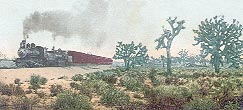
• Part of Papa's plan was that we each be given a daily allowance to spend as we would—" 'Twill teach them responsibility," Papa said, to which Mother responded, " 'Twill teach 'em to be spendthrifts!"—and it was young Frederick Johan's lot to receive 25¢ every morning at breakfast. Now, Estelle, dear, I must tell you that it is evidently the practice on these long trips that traveling salesmen—very traveling salesmen—roam about on the railroad cars, hawking whatever wares they have to dispose of. And so it was that young FJ spent a portion of his largesse on a picture of a Horny Toad. Mother looked sharply at Papa and said, "I told you!" Minnie could hardly look at the picture; "Good heavens," she said, "why on earth did you want such a hideous thing? It looks positively satanic." "Oh, I don't know, Minnie," I ventured, "I think it has a rather amiable look," which made Minnie frown at me. "They're very interesting creatures," said young FJ, not the least bit chastened. "Their eyes look so wise," Anna said softly as she gazed at the picture. "They're really lizards," was Charley's comment. Young FJ pointed out that "it says 'toad' right here." "Be that as it may, they're lizards." Just then, the conductor came by. Young FJ took him by the sleeve and, covering up the caption on the picture, asked him what this was a picture of. The conductor looked at it first with one eye—his wide one—and then with the other—his narrow one—and then with both. "That, son, is a fine picture of a Horny Toad. Now get back to your seat." Charley heaved a deep sigh; "Nevertheless, it is a lizard." Minnie wrinkled up her face and said, "Disgusting is what it is; please put it away."
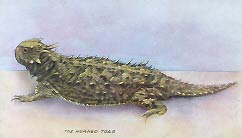
• The interior of the train (left);
the train goes through Southern California's Cajon Pass, leaving the
desert and nearing the coastal plain and Los Angeles
(right).
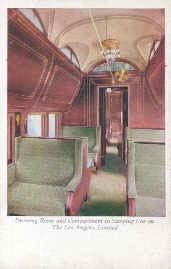 | 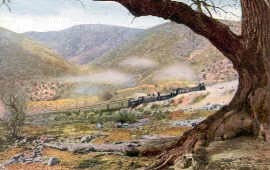
|
• Now and then, as we
traversed the back-country of Southern California, we would pass some
neglected buildings. "The past calls to us!" declared Papa, impressing the
scene on his memory. "The past," quoth Minnie, fanning herself with a
brochure, "would do better to send a telegram."
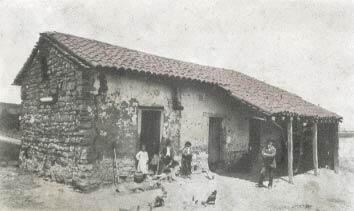
• The abandoned buildings here and there now began to alternate with fields of crops and farm houses; even the old buildings among them seemed more cared for. A similar change was taking over within the train cars; a sort of electricity animated the passengers as we realized that we would soon be in Los Angeles!
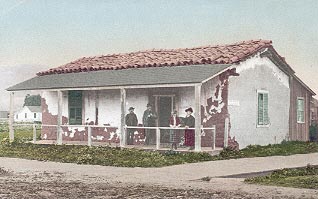
Arrival; the Plaza; Main St. south to Temple St.
• The perfume of orange blossoms wafted over us as we approached the city. Just like a wedding, dear...
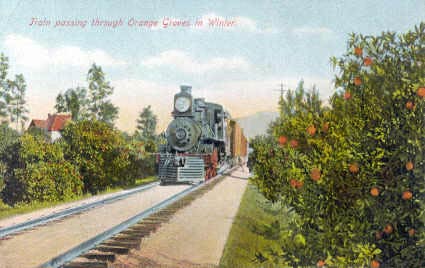
• Los Angeles had several
train stations once upon a time. Let us say that our family arrived at
Santa Fe's La Grande station. "Great heavens!" cried Mother, as we stepped
off the train onto the platform; "Are we in Los Angeles or—Baghdad?".
Charley sighed. "Los Angeles," he said. In Mother's arms, the baby
reached for the sun, as if it were an orange.
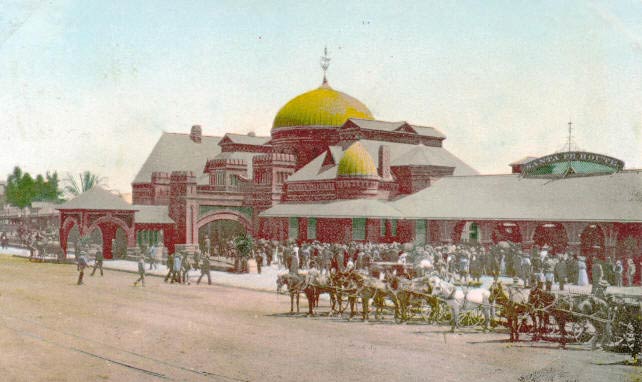
• We of course were to be met at the station by Aunt Sigrid, who had advised us in her last letter that there could be some delay in her arrival due to her obligations—which perhaps calls for some explanation. I don't believe that I've ever mentioned it to you before, but, in their younger days, while Papa and his brother old Frederick Johan were plying their way north and south along the Mississippi, Aunt Sigrid was going east and west through the prairies as something of an entertainer; and indeed Papa had among his possessions an old frontier newspaper which mentioned her as "The Belle of the Platte, warbling her way through the camps and trilling the culture-hungry settlements as she played at her trusty piano Erasmus." Now, I've never otherwise heard of anyone bestowing a personal name upon a piano; but there you have it, in black and white. She had something of a theatrical air at times—this was of course the first time that Mother or any of the children had met her, and you can bet that Mother gave her quite the looking over—and her piano-playing, as we found that night, while skilful, still somehow carried an air of prairie theatricals with it. Anyhow, Aunt Sigrid was now backup rehearsal pianist at a local theater; and these were the obligations she had to be somewhat delicate about, and this was why we had to cool our heels at the station while we awaited her arrival. There was a "Free Information Bureau" nearby. As Papa was looking after the baggage, young Frederick Johan slipped away through its doors, Anna and me in hot pursuit. He stepped right up to the counter. "Sir," said young FJ, with that self-important look all his own, "I should like some free information." The clerk looked up blandly, and said, "Certainly; it would be my pleasure. In 1879, California produced 2,459 gallons of sorghum molasses. Is that enough free information for you?" "Thank you, sir," said I, catching up with FJ, "that will do." "Thank you, sir," said the clerk, as Anna and I escorted our brother out the door.
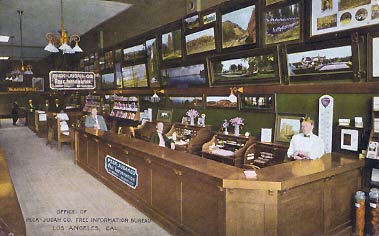
• Aunt Sigrid had a friend named Arthur who owned an automobile, of all things, and so it was that the two of them rolled up to us—we were the only passengers left waiting out on the street by that point, and there was no missing Papa at any time—and whisked us away towards her home on the far side of downtown. On the way, Papa asked her about her piano-job. "Well," said she, "they need me for morning rehearsals and such Tuesdays, Saturdays, Wednesdays, Thursdays, Fridays, Mondays, and very frequently Sundays." As she went on, Papa counted on his fingers up to seven, and said "And you are the back-up pianist, Sigrid?" "Yes, yes," said she, "that's it. The regular pianist is ill. In fact, he's an invalid." She hesitated for a moment, then added, "The truth of the matter is that he has been dead for a year and a half." "That's pretty ill!", was young Frederick Johan's comment. Charley struck in at this point, and said, "But then why don't they make you the regular pianist?" "Oh," she said blithely, "the manager is saving that for his daughter. She's twelve." Anna ventured that the daughter must be very talented. "Yes, it's true, her talent positively shines—you've never seen anyone tear a ticket at the door with quite the panache of Dorinda. But I don't believe she has ever sat down at a piano in her entire little life." At this, Arthur sighed, bit his lip, and shook his head sadly as he drove, we travelers looking in wonder at the buildings eight, ten, twelve and more stories tall—"skyscrapers," as Aunt Sigrid called them—but we skirted that part of town because the streets seemed too narrow to hold all the carts, horses, carriages, pedestrians, trolleys, automobiles and other what-not bustling about. What with all the go-ers congesting the narrow streets, and the tall buildings chock-a-block trying to shoulder each other out, and the general noise and hurly-burly, it was like a town which was surprised to wake up and find itself grown into a city. I noticed Minnie looking about as well as she could—she was stuck between Papa and myself—and with an ambiguous look on her face. "Quite a mix!" she whispered to me when our eyes met. The lot of us settled in nicely at Aunt Sigrid's that evening, the boys all rooming together at one end of the second floor corridor, the girls at the other, and Mother, Papa, the baby, and of course Sigrid downstairs. At breakfast, Papa declared himself quite pleased with the look of the place—he meant the city in general—"quite pleased indeed, yes I am!", said he, adding in effect that every inch would happily come under his scrutiny—the happily pertaining most closely to him, I think, as his comprehensive nature can prove somewhat challenging to others at times, I've found. Charley took the bit in his teeth, though, and said that it would perhaps be best historically speaking to begin our rambles at the old center of the city; and thus it was that we soon found ourselves at the plaza and church of El Pueblo de Nuestra Señora la Reina de Los Angeles de Porciuncula, where the city began. (Fort Hill can be seen in the background of this image.)

• The church's Victorian-era
cupola was replaced with a more in-character—though certainly less
distinctive—belltower (left); the modest but powerful interior of the
church (right).
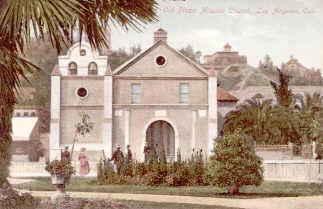 | 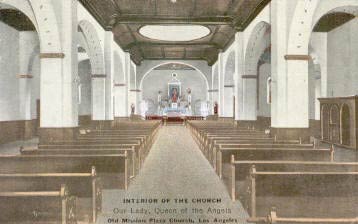 |
• Young Frederick Johan and I
peeked
into the interior courtyard of the Plaza Church.
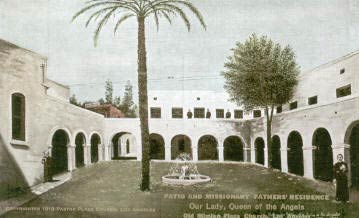
• But let's step out into the
Plaza again, and look at our surroundings, going clockwise around the
Plaza. First, a broader view to the west.
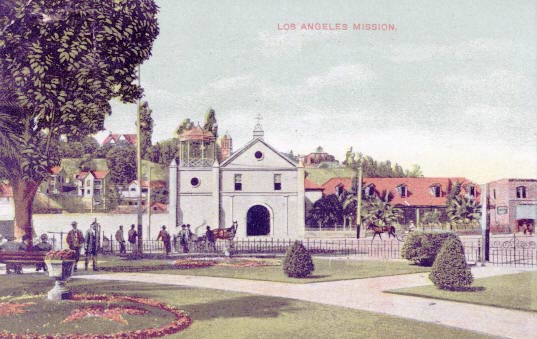
• And now we look to the
northwest, where Main Street exits the Plaza.
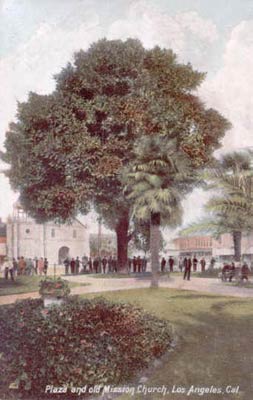
• To the north (left); and to
the east, towards China Town (which was at length to be replaced by the
grand Union Station buildings, a new China Town to be built northwards).
The gentleman eyeing you warily is a policeman, so please
behave!
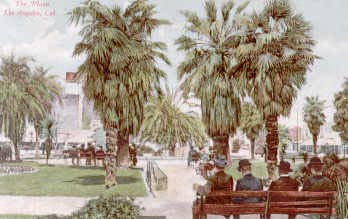 | 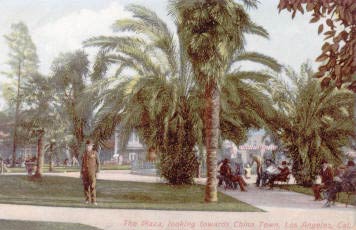 |
• Now, to the southeast: The
fire-house looks on the Plaza from the southeast corner of the square. At
the right in this image, we see the rear wall of the Pico House hotel,
which is at the southwest corner of the square. We'll look at the
front of the Pico House in a moment.
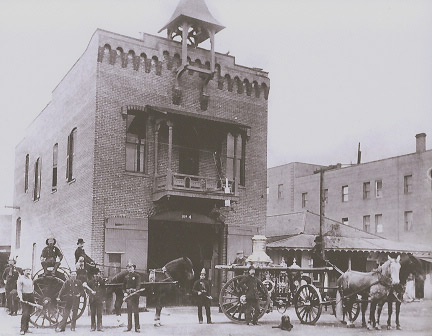
• And finally we look to the
west, where Main Street enters the Plaza area from the south; looking
carefully, we can catch a glimpse of the storefronts and the Church again
through the trees.
• The building on the east side of Main Street at the southwest corner of the Plaza is the hotel Pico House, built by the man who had been the last Mexican governor of California, Pio Pico; it opened in 1870, the city's first 3-story structure. We see it here on the left—the Plaza can be barely glimpsed at the extreme left—with its neighbors to the south on Main Street, the Merced Theater and the Masonic Lodge.
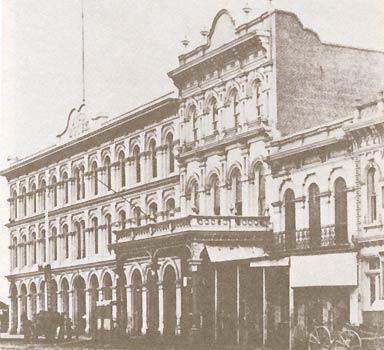
• This area, for a few blocks south on Main from the Plaza, had been the business district of Los Angeles in pueblo days up to into the 1870s, after which the city developed southwards. At the southeast corner of Main Street and Arcadia Street, about a block south of Pico House, is the site of the magnificent Baker Block, the last flowering of this old business area of the city.
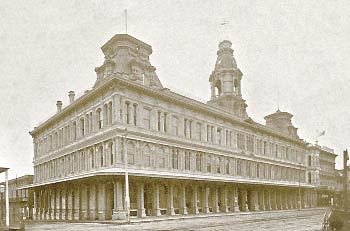
• Across the street from the Baker Block—which is to say, the west side of the 400 block of N. Main Street—is this scene. The cars are from the 1930s; but the appearance of the buildings is very much as it had been decades earlier. The Brunswig Drug Company is across the lane to the right; the lane has had many names over the years—Republic St., Sonora St., Hayes Alley, Bridge St., and no doubt others. Looking deeper into the picture, we see the next street to the west, New High St.
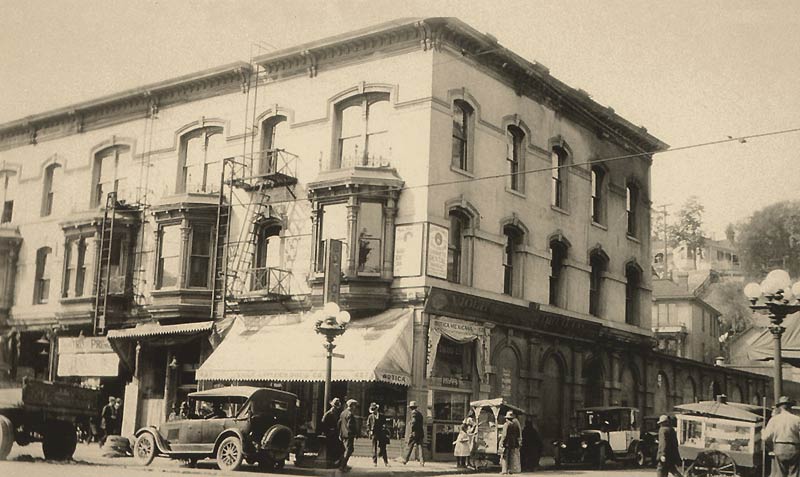
• And here is the south part of the same building, with its neighbors further south.
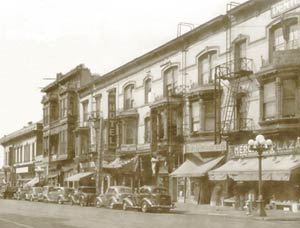
• The east face of Main Street between Arcadia Street and Commercial Street, which is to say from the Baker Block to Ducommun Corner. At center, behind the pole, is the St. Charles Hotel, originally the Bella Union Hotel which was the main hotel in the 1850s. On the building's side wall, one can still make out some of the fading letters indicating "Bella Union."
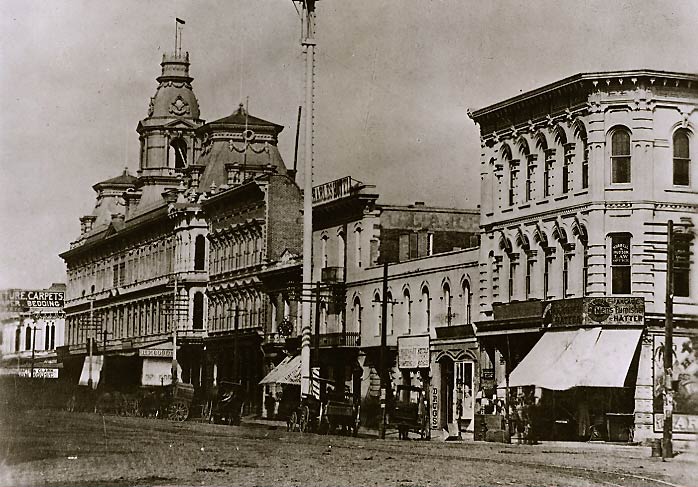
• As its name indicates, Commercial Street—formerly Commercial Row—was originally the very heart of Los Angeles's business community. This view looks east up Commercial Street from Main towards its corner with Los Angeles Street. This corner was known as "Ducommun Corner" from the pioneer hardware merchant who originally had his shop here.
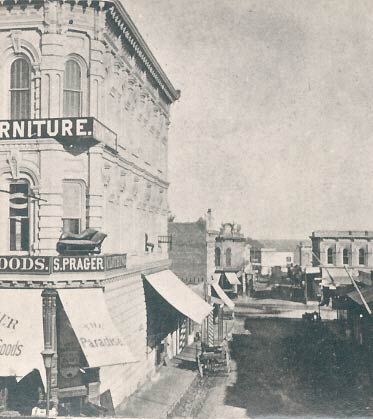
• Let's look north on Main Street from this point. The near corner of the previous image is the corner facing us on the right in this picture; Commercial Street goes off to the right, while Main Street goes deep into the picture. The Baker Block is at center, and the Plaza is a block beyond that. At the near left is the Downey Block. The Downey block continues out of the picture towards the left, along Temple Street, where it faces the head of Spring Street; when we begin our visit to Spring Street, we will find that the Downey Block has been replaced by a grand new Post Office.
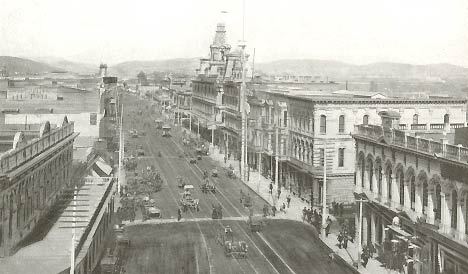
• Had the photographer of the above been about twenty-five feet lower, and a little bit to the left, and twenty-five years earlier, here is how the scene would have looked. The Baker Block had not been built; in its place, we see the El Palacio of Abel Stearns and his wife Arcadia, a rambling adobe the kernel of which dated back to about the 1830s. Beyond El Palacio, we can make out the Masonic Lodge, and the upper stories of the Merced Theater and, farthest, Pico House. Dominating the view on the left is the Downey Block in an early state, with only the farther part of the boardwalk covered. Behind us and to the left (west) is the north end of Spring Street; what we see immediately below us is where it angles into Main Street. On this side of El Palacio, we see the U.S. Bank and the well-known Bella Union Hotel, alias the St. Charles.
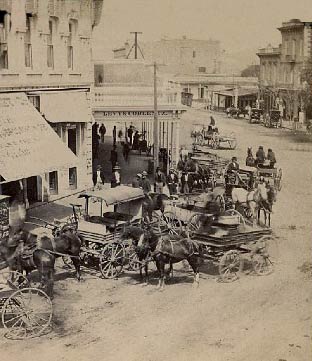
• Here is a bird's eye view from the southwest over this oldest business section of Los Angeles. Main Street bisects the view, at the center, left to right (respectively north to south) at a slight angle. We can pick out the Baker Block about a third of the way in from the left. Just right of center is the corner of Main and Los Angeles streets which we saw in the previous image. The intersection which we can see, largely in shadow, at the lower right margin, is the junction of Main, Temple, and Spring, Temple being the street running to the bottom margin, and Spring being unseen except for the sunlight it has allowed through to the intersection. This intersection is called Temple Square, and was considered the business center of the city for many years. The street extending into the distance at the back of the view is Aliso Street. Before continuing south past Temple Street our survey of Main Street, let's see what lies east of the Plaza and of Main . . .
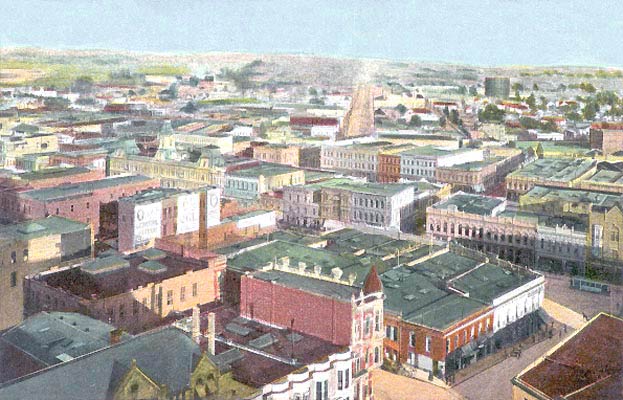
To continue east of Main Street...